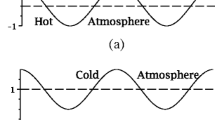Abstract
We consider the problem of gravitational instability (Rayleigh–Taylor instability) of a horizontal thin gas layer between two liquid half-spaces (or thick layers), where the light liquid overlies the heavy one. This study is motivated by the phenomenon of boiling at the surface of direct contact between two immiscible liquids, where the rate of the “break-away” of the vapor layer growing at the contact interface due to development of the Rayleigh–Taylor instability on the upper liquid–gas interface is of interest. The problem is solved analytically under the assumptions of inviscid liquids and viscous weightless vapor. These assumptions correspond well to the processes in real systems, e.g., they are relevant for the case of interfacial boiling in the system water-n-heptane. In order to verify the results, the limiting cases of infinitely thin and infinitely thick gas layers were considered, for which the results can be obviously deduced from the classical problem of the Rayleigh–Taylor instability. These limiting cases are completely identical to the well-studied cases of gravity waves at the liquidliquid and liquid–gas interfaces. When the horizontal extent of the system is long enough, the wavenumber of perturbations is not limited from below, and the system is always unstable. The wavelength of the most dangerous perturbations and the rate of their exponential growth are derived as a function of the layer thickness. The dependence of the exponential growth rate on the gas layer thickness is cubic.
Similar content being viewed by others

References
Lord Rayleigh (Strutt, J.W.), Investigation of the character of the equilibrium of an incompressible heavy fluid of variable density, Proc. London Math. Soc., 1882, vol. s1-14, pp. 170–177.
Taylor, G., The instability of liquid surfaces when accelerated in a direction perpendicular to their planes, Proc. R. Soc. London A, 1950, vol. 201, no. 1065, pp. 192–196.
Sharp, D.H., An overview of Rayleigh–Taylor instability, Physica D, 1984, vol. 12, nos. 1–3, pp. 3–18.
Pimenova, A.V. and Goldobin, D.S., Boiling at the boundary of two immiscible liquids below the bulk boiling temperature of each component, J. Exp. Theor. Phys., 2014, vol. 119, no. 1, pp. 91–100.
Pimenova, A.V. and Goldobin, D.S., Boiling of the interface between two immiscible liquids below the bulk boiling temperatures of both components, Eur. Phys. J. E, 2014, vol. 37, no. 11, p. 108.
Wang, C.Y., The three-dimensional flow due to a stretching flat surface, Phys. Fluids, 1984, vol. 27, pp. 1915–1917.
Author information
Authors and Affiliations
Corresponding author
Additional information
Original Russian Text © A.V. Pimenova, D.S. Goldobin, 2015, published in Vychislitel’naya Mekhanika Sploshnykh Sred, 2015, Vol. 8, No. 2, pp. 200–207.
The article was translated by the authors.
Rights and permissions
About this article
Cite this article
Pimenova, A.V., Goldobin, D.S. Gravitational instability of thin gas layer between two thick liquid layers. J Appl Mech Tech Phy 57, 1182–1189 (2016). https://doi.org/10.1134/S0021894416070117
Received:
Accepted:
Published:
Issue Date:
DOI: https://doi.org/10.1134/S0021894416070117


